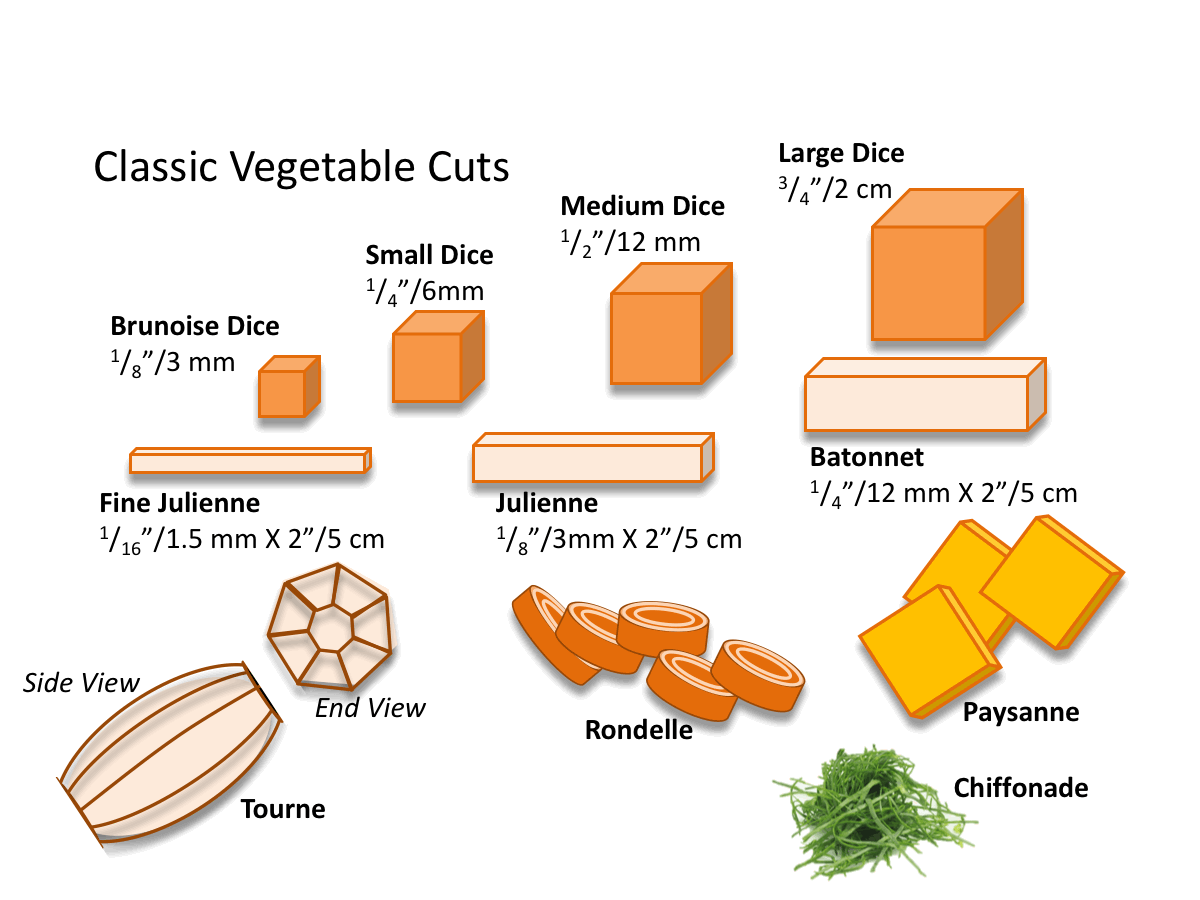Chef Cuts
Learn the vocabulary for the different cuts and how to make easy and safe cuts.
If you have read many of our recipes, we usually give you a few ways to cut your veggies or herbs. If the terminology confuses you is ok now you will learn. These are the most used terms in recipes overall when it comes to cutting vegetables.
CUTS —
Chop:
This is a general method for cutting food into bite-sized pieces (about 1/4-inch in size, or the thickness of a pencil). A large-bladed chef’s knife is helpful for chopping, dicing, and mincing When a recipe calls for finely chopped, aim for pieces about 1/8-inch in size (or half the thickness of a pencil). When the recipe specifies a coarse or rough chop, chop larger pieces (but no more than about the size of a quarter). Cooking times impact how quickly the size of the chopped food will cook, which is why it’s important to chop approximately to the size called for in the recipe.
Dice:
Dicing is similar to chopping, except dicing is always finely chopped, consistent in size, and neat in appearance. It’s the precision of the cut that distinguishes dicing from chopping. Feel free to finely chop for home recipes.
Julienne:
To julienne is to cut food (usually vegetables), into matchstick sized pieces. This can be very time consuming.
Mince:
This is the finest level of chopping, and is frequently done using a food processor, or a sharp chefs knife. Mincing is a technique that allows the maximum amount of flavor to be contributed by the mined food; frequently the minced vegetable is chopped so finely that it “melts” into the dish. Mincing will definitely impact the taste of the food, if called for in a recipe. We usually reserve this for garlic.
MEDIA:
Watch the videos for visual instructions.
KNIFE SKILLS 101
First step you learn before cutting is to make sure that your cutting board is stable and not moving around while you cut. An unstable cutting board can be dangerous, and you may cut yourself. a better method is to put a damp cloth underneath the cutting board to secure it in place. Next, make sure that the ingredients you use are not rolling around on the cutting board. It might be easy to control small foods, like herbs, but larger items like onions, cucumbers even carrots can roll around on the cutting board making it dangerous, So here’s a tip to make it easier to cut relatively large ingredients, you'd want to cut one side off just a small piece so that it has a flat end and you can see it's not rolling around on the cutting board which is going to make it a lot safer to cut.
Safety
• Keep your blades sharp!
• Only cut on appropriate surfaces, never on metal, glass, or hard stone such as marble or granite.
• Never attempt to catch a falling knife.
• Use the right knife for the task at hand.
• Never use a knife for any purpose other than what it was intended – e.g., never use your knife to open a can or pry something loose.
• Do not leave your knives in a sink full of water.
• Pass a knife by its handle.
• Always cut away from yourself; never cut towards yourself.
• Learn and use the proper grip for your knife.
• Keep fingers on guiding hand curled.
• When walking with a knife, hold it closely to your side with the tip-end down and the blade facing away from you.
Knife Care
Here’s how to keep your blades sharp.
* Wash by Hand. Dishwashers are harsh on blades: Knives can hit other items or corrode from food or water. Wash them in warm soapy water, then dry and store.
* No Scraping! After chopping, avoid scraping the blade across the cutting board to move ingredients. Use the blunt side of the knife instead.
* Sharpen Regularly. Look for knife-sharpening services at specialty grocery or kitchenware stores. Dull knives do a sloppy job — and they’re dangerous, too
ESSENTIAL KNIVES:
Tackle any kitchen task with these three basic blades.
* Chef's: This all-purpose knife (8- to 10-inch blade) is your go-to for most prep work. It can handle small jobs, like mincing garlic, or big ones, like breaking down squash or carving meat.
* Serrated: The saw-toothed edge of this long knife is essential for cutting bread but also does a great job slicing ripe tomatoes or trimming cake layers.
* Paring: A small, sturdy paring knife (3- to 4-inch blade) is key for detail work, like deveining shrimp, hulling strawberries and other tasks that require precision.
 |  |  |
|---|---|---|
 |  |  |
 |  |  |
